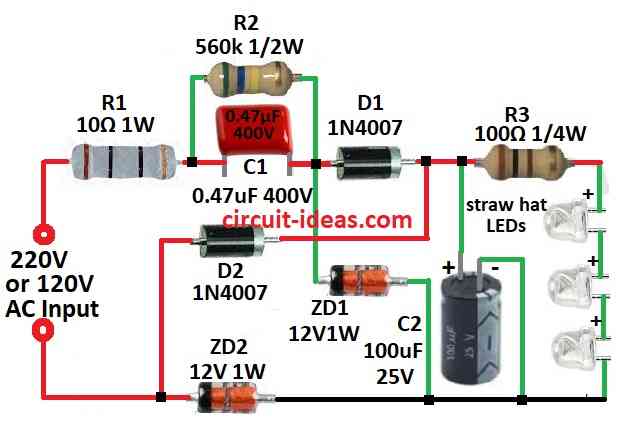This Simple 220V LED Night Lamp Circuit design make night light work straight from home power plug which is usually 220V AC.
It does this by using small transformer or special capacitor to drop voltage low so LED lamp can work safe.
Circuit Working:

Parts List:
| Type | Value | Quantity |
|---|---|---|
| Resistors | 10Ω 1W | 1 |
| 560k 1/2W | 1 | |
| 100Ω 1/4W | 1 | |
| Capacitors | PPC 0.47µF 400V | 1 |
| Electrolytic 100µF 25V | 1 | |
| Semiconductors | Zener diodes 12V, 1W | 2 |
| Diodes 1N4007 | 2 | |
| LEDs straw hat white 5mm | 3 |
Nowadays white LED light is good option instead of old incandescent bulb for light use.
New white LED is not costly much but it uses less power and gives sharp light beam.
Here is simple circuit that show how to make white LED night lamp run direct from 220V AC socket.
This uses “capacitive transformerless power” which means one capacitor and resistor connect in line with AC power.
It helps to control current if capacitor value is big compare to resistor.
With 0.47µF capacitor the circuit gives around 70mA current from 220V AC and 50Hz.
To change AC to DC we have used rectifier and filter capacitor.
This circuit uses 12V DC and 70mA power from capacitor type supply to run 3 small 5mm white LED which is straw-hat type.
Good part is output voltage stay safe even if LED is not connected.
This safe part happen because of two Zener diodes ZD1 and ZD2 inside bridge rectifier.
In old type circuit if there is no load LED will disconnect and filter capacitor can blow up.
Resistor R1 stops big inrush current when power is ON and It balances heat and current.
Capacitor C1 is main part as it control how much current passes in the circuit.
Electrolytic capacitor C2 keep power for LED and need double voltage rating than output voltage.
Resistor R3 limit how much current goes through the 3 white LEDs from LED1 to LED3 in series.
This small circuit is good to give light in stair, hallway, cupboard, bedroom or bathroom.
Formulas:
In transformerless capacitive power supply we have used one capacitor to drop high mains voltage to low safe level.
How much voltage, current and ripple comes out depends on input capacitor size.
Formula for Input Capacitor C1:
C1 = Iout / (2 × f × Vripple)
where:
- C1 is capacitor value in farads.
- f is frequency in 50Hz or 60Hz.
- Iout is output current in amps.
- Vripple is ripple voltage we allow from peak to peak.
Note:
With this formula and circuit idea we can make 220V LED night light easily and just understand how parts work together.
How to Build:
To build a Simple 220V LED Night Lamp Circuit follow the below mentioned steps:
- Always remember when there is no power when making the circuit then do not touch live wire!
- Take 0.47µF capacitor C1 and resistor R1 and join them in series and then connect to 230V AC.
- R1 must stop big current at start inrush but should not get too hot.
- Value of R1 depend on how much current and voltage we need.
- Put big capacitor C2 across output in parallel.
- C2 must be rated double than what voltage we expect out.
- Connect resistor R3 and 3 white LEDs from LED1 to LED3 in series.
- R3 control how much current connects to LEDs.
- Pick value of R3 and LEDs based on how bright we want light and how much current we need.
- After circuit building is done then test circuit with power.
- If light is too dim or too bright change R1, R3 or LEDs until it look right.
- When all working is fine put the circuit in a plastic or safe box.
- It stop shock risk and help spread LED light nicely.
Note:
- High voltage is very dangerous so we should be very careful.
- If anyone is not sure or new to electronics then we should ask help from expert person.
Conclusion:
A Simple 220V LED Night Lamp Circuit is easy and works well to power small night light from normal 220V AC power at home.
With some parts like capacitor, resistor, Zener diode and bridge rectifier we can make safe and strong circuit to light up LED in many places like bedroom, hallway or cupboard.
Leave a Reply